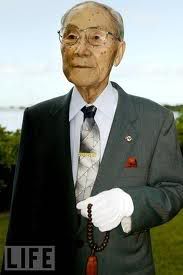Zenji Abe, a japanese pilot.
Zenji Abe, one of the pilots who bombed Pearl Harbor, was born in 1916 in a small mountain village in Yamaguchi.-
The day of the attack, Abe got up at three o'clock .- For such an important mission, he and his comrades wore his dress uniform under the guise of an aviator.
After writing a letter to his wife and left in his locker, he visited a Shinto altar and performed his prayers. He joined the rest of his teammates for breakfast and receive the final report of the attack.
Throughout the ship resounded with the roar of jet engines warming up on the flight deck.
A quarter of an hour took the 167 units of the second wave to take off six ships and line up in battle formation.
A considerable feat, testimony to the skill of these pilots, who had strictly forbidden the airline radio contact with the boat.
In view of forced silence, the aircraft flew in close formation, making eye contact as possible with hand signals and facial gestures.
Among the aircraft wings, which were squads from nine to nine, there was more than a meter away .- Each squadron flew at different altitudes to avoid turbulence from the propellers.
"Mine was on the highest point and delayed the surge, which had a good view of all those in front. I felt proud, like a shepherd leading his sheep." His memories of the attack itself focuses on how well the Americans were recovered after the initial surprise, 30 minutes before they arrived.
As the leader was down to two of his colleagues before he could swoop in on the USS Arizona.
Three bombers were killed following him under intense antiaircraft fire. Back, with many of their dead comrades and saw the damage of the aircraft, the stark reality of war hit him and threw over it the shadow of doubt on the conflict.
Abe took part in five other actions in World War II .- The last one was in a no-return mission to bomb the naval battle group number 58 in the U.S..
His attack would make it beyond the point of return, unable to return to his ship by the lack of fuel, would have to make an emergency landing somewhere near the point of attack.
After locating the fleet, three aircraft carriers surrounded by a score of ships sailing in concentric defensive gave his squad the order to attack at the same time throwing his equipment into a tailspin by a hail of flak.
Recovered height and waited for his companions .- At that time, several fighters were launched against him, but avoided by hiding behind the clouds. With their fuel running low, he managed to land on the tiny island of Rota (in the Western Pacific, 32 miles from Guam).
Of the 430 aircraft that participated in the attack, only 30 saved. On August 15, 1945, Abe was surrendered to U.S. troops.
After the war, lost contact with their former comrades in arms. Later, in 1991, to mark the 50 anniversary of the attack, was invited to attend the commemorations organized by the U.S. Pearl Harbor Association.
His desire for forgiveness led him to form the Japanese Friends of Pearl Harbor .-
Make a list of survivors who at that time numbered about 80, and went to visit each of them to explain what he was doing.
Participated in acts of reconciliation, helping to heal some deep wounds that were opened during those days.
Abe died on April 6, 2007.-















